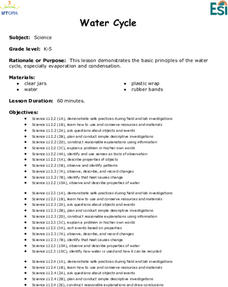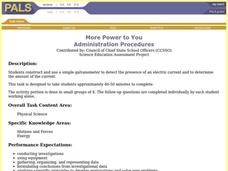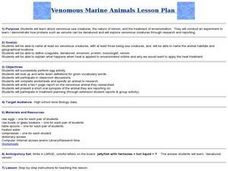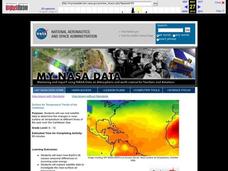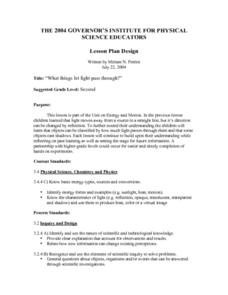Curated OER
Melting, Freezing, and More!: Phase Transitions
Third graders listen to a talk on phase transitions and view three demonstrations. In this phases of matter instructional activity, 3rd graders complete a worksheet as they listen about phase transitions. They move through three...
Curated OER
Demonstration of Factors Affecting Soil Temperature
Students examine the influences of water and mulch on soil temperature. For this investigative activity students complete a soil experiment.
Curated OER
Review For Weather Quiz 2
In this science worksheet, students look at the information carefully in preparation for a formal assessment. The focus is upon defining different aspects of air masses.
Curated OER
Energy
Young scholars distinguish between kinetic an potential energy. They recognize that energy is conserved when changing from one form to another. Students compare the scientific meaning of work with its everyday meaning.
Curated OER
Discovering Chemical Changes
Fourth graders predict what happens in a teacher demonstration of a chemical change, before watching it. They observe the demonstration and list what the see on the board before determining which represent chemical change. Working at...
Curated OER
Sustainable Choices
Students examine energy use and the different construction materials used in their home. In this sustainable choices lesson students study different materials and what a sound environmental choice would be.
Curated OER
Vibrant Volcanoes
Students explore volcanoes. In this science instructional activity, students discuss the characteristics of volcanoes and view a video segment about a volcano. Students examine plate tectonics.
Curated OER
Water Cycle
Pupils perform experiments with water to observe the principles of evaporation and condensation. They make models of the water cycle and discuss the processes that occurred in their experiments with their jars of water.
Curated OER
The Miracle Fish: Learning to Design an Experiment
Students develop procedures to explore the behavior of fish. In this scientific experiment lesson students from a hypothesis, write a question, identify different variables and controls in their experiment.
Curated OER
What’s That, I Can’t Hear You?
Students investigate forms of energy as well as light and sound. In this science instructional activity, students participate in hands-on activities that require them to evaluate how sound affects astronauts in flight. A video of this...
Curated OER
As a Matter of Fact!
Students explore matter. They use a formula to measure the volume of matter.
Curated OER
More Power to You
Students construct a simple galvanometer in order to detect the presence of an electric current as well as determine the amount of the current. Activity is divided into two parts, first part as group work and second as individual.
Curated OER
What Does Motion Have to do with Sound?
Second graders investigate and explore sound energy. They investigate how the vibrational motion moves through matter in waves. Students describe sounds and vibrations. They observe that vibrational motion creates sounds. Students record...
Curated OER
Venomous Marine Animals
High schoolers name and describe six venomous marine animals. After participating in an activity, they define new vocabulary words. In groups, they complete worksheets to use while researching a specific venomous animal of their...
Curated OER
Surface Air Temperature Trends of the Caribbean
Students investigate the seasonal changes to sea surface and near-surface air temperatures near the equator. They use actual satellite data to track and graph the differences in air and sea temperatures during different seasons in the...
Curated OER
Survival Still
Students explain how to desalinate water using solar energy. In this solar lesson plan students complete a lab activity and explain capillary water.
Curated OER
Metalloids
Students discuss metalloids, their use as semiconductors, and their impact on the computer industry. They work in groups to create a visual timeline showing the evolution of the computer.
Curated OER
Properties of Ionic Compounds
For this compounds worksheet, students describe why metals and nonmetals form ionic compounds and why the formation of ionic compounds are exothermic. This worksheet has 5 short answer questions.
Curated OER
Metals, Non-Metals, Metalloids
Students describe properties of various elements. They arrange the elements based on properties in order to explain the organization of the periodic table. They label elements as metal, non-metal, or metalloid.
Curated OER
When You're Hot, You're Hot!
Eighth graders examine the development of the different temperature scales. They experiment with hot and cold temperatures.
Curated OER
Block the Sun, Not the Fun
Young scholars discover ways to protect themselves from the sun. They identify diseases that are caused by too much sun exposure. They take a quiz and measure their progress throughout the year.
Curated OER
What things let Light Pass Through?
Second graders classify objects according to how well light can pass through them and predict how well objects will transmit light. They experiment with objects to verify predictions while collecting, recording, and interpreting data...
Curated OER
The Layers of the Atmosphere
In this atmosphere worksheet, students read about the four distinct layers of the atmosphere. Then students complete 3 short answer questions.
Curated OER
Investigating and Using Biomass Gases
Students examine the definitions of biomas gasification and generate their own biomass gas. In this renewable energy lesson students collect gases and roast a marshmallow.









